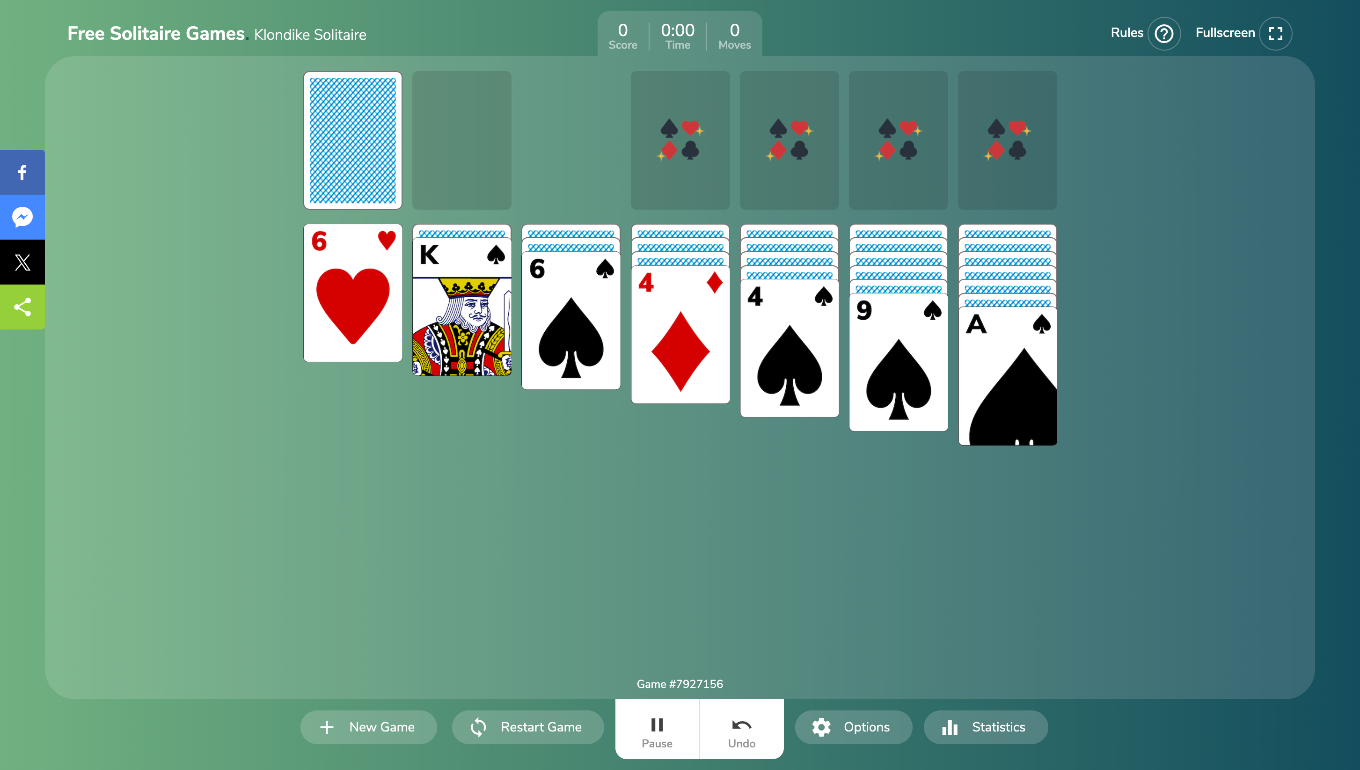FREE SOLITAIRE GAMES

Frequently Asked Questions
-
Is Solitaire really free to play on this website?
Yes! All games on Free-Solitaire-Games.com are 100% free forever with no hidden costs, premium features, or subscriptions. Play unlimited games without any restrictions.
-
Do I need to download anything to play Solitaire?
No downloads required! All Solitaire games run directly in your web browser using HTML5 technology. Simply visit the website and start playing instantly on any device.
-
Can I play Solitaire on my mobile phone or tablet?
Absolutely! Our games are fully optimized for mobile devices, tablets, and desktops. The interface automatically adapts to your screen size for the best experience.
-
What is the difference between Turn 1 and Turn 3 Solitaire?
Turn 1 draws one card at a time from the stock pile (easier, 33% win rate). Turn 3 draws three cards at once but only the top card is playable (harder, 11% win rate). Turn 1 is recommended for beginners.
-
Are all Solitaire games winnable?
Research shows 82-91% of Klondike Solitaire games can be solved with perfect play. FreeCell has 99.99%+ solvability. The actual win rate depends heavily on your strategy and decision-making skills.
-
How can I improve my Solitaire win rate?
Focus on: (1) Always revealing face-down cards when possible, (2) Checking the first stock card before making moves, (3) Moving Aces and 2s to foundations immediately, (4) Not emptying columns without a King ready, (5) Prioritizing longer columns with more hidden cards.
-
Can I undo my moves if I make a mistake?
Yes! All games include unlimited undo feature, perfect for learning and testing different strategies without restarting the entire game.
-
Is Solitaire a game of luck or skill?
Solitaire combines both. While initial card deal involves luck, winning depends heavily on strategic thinking. Studies prove skilled players win far more often than beginners with the same arrangements.
-
How long does it take to learn Solitaire?
Basic rules can be learned in 5-10 minutes. You can play competently within your first few games. Strategic mastery develops over weeks or months of regular practice.
-
Can playing Solitaire benefit my brain?
Yes! Research shows Solitaire improves strategic thinking, enhances memory, boosts problem-solving, increases concentration, and helps maintain cognitive function. It also provides stress relief.
-
What should I do when I get stuck in Solitaire?
Try: (1) Using the Hint feature, (2) Undoing last moves and trying different approaches, (3) Moving cards from foundations back to tableau if allowed, (4) Looking for alternative sequences, (5) Starting a new game—not all deals are solvable, though most are with the right strategy.
-
Can I play Solitaire offline?
Our web-based games require internet connection to load initially, but once loaded, most functionality works offline. Bookmark the page for easier access.
-
What Solitaire variations are available?
We offer Classic Klondike (Turn 1 and Turn 3), Spider Solitaire (1-suit, 2-suit, 4-suit), FreeCell, Pyramid Solitaire, TriPeaks, and more. Each variation offers unique challenges and strategies.
-
Why do I keep losing at Solitaire?
Common mistakes include: moving cards to foundations too early, not prioritizing face-down card reveals, creating empty columns without Kings, and not planning ahead. Focus on revealing hidden cards first.
-
Is there a way to play only winnable Solitaire games?
Some platforms offer 'winnable deals' that are pre-tested. While solvable, finding the solution still requires skill. Check game settings to see if this feature is available.
-
How does Solitaire scoring work?
Scoring varies but typically awards points for moving cards to foundations, revealing face-down cards, and completing games. Points may be deducted for moves, stock pile cycles, and time taken.
-
What is the difference between Solitaire and Patience?
They're the same game! 'Patience' is the European (especially British) name for Solitaire. Both terms refer to the same family of single-player card games.
-
Can I compete with other Solitaire players?
While fundamentally single-player, many platforms offer leaderboards to compare scores, times, and win rates globally. Some offer daily challenges where everyone plays the same deal.
-
What makes Klondike the most popular Solitaire variation?
Klondike offers the perfect balance of simplicity and strategic depth. It's easy to learn in minutes but provides endless challenges. It was also popularized by Microsoft Windows since 1990.
-
How many cards are used in Solitaire?
Classic Klondike Solitaire uses a standard 52-card deck (no jokers). Spider Solitaire uses 104 cards (two decks). The number varies depending on the variation you're playing.

